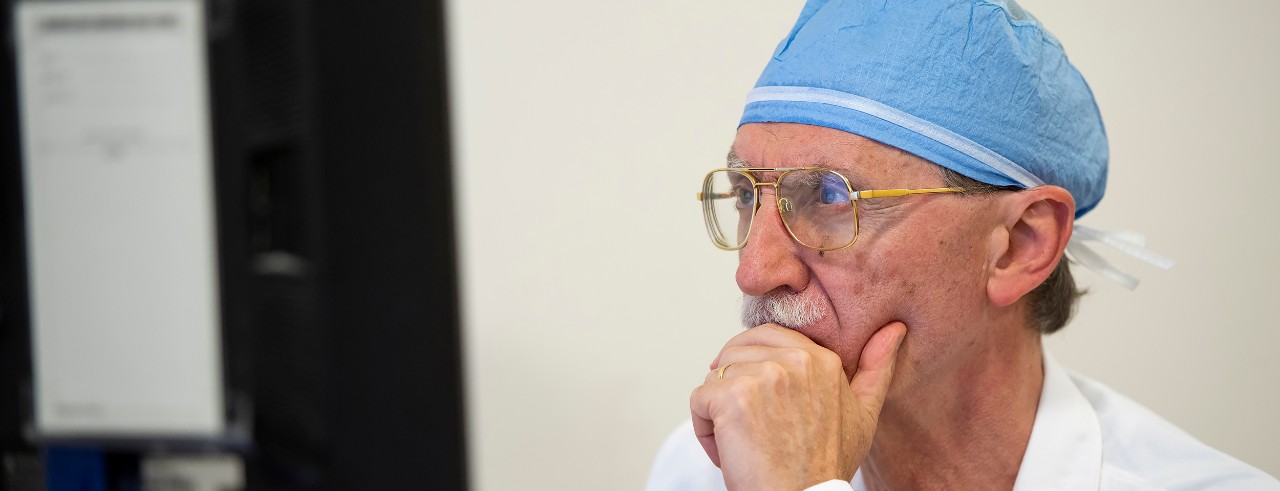
Zuccarello named director of UC Brain Tumor Center
Will head center within UC Gardner Neuroscience Institute and UC Cancer Center
Mario Zuccarello, MD, has been appointed director of the Brain Tumor Center at the University of Cincinnati Gardner Neuroscience Institute and the UC Cancer Center.
Zuccarello, a professor in the Department of Neurosurgery, has been a faculty member since 1990. He currently also serves as director of the neurosurgery department’s Division of Skull Base Surgery. Previously, he served as chair of the Department of Neurosurgery from 2009 until 2017.
“It is a great honor to be appointed director of the Brain Tumor Center, especially because I am also the recipient of John M. Tew, MD Chair in Neurosurgical Oncology,” Zuccarello says. “I will work very hard to make the Brain Tumor Center a world-class center and a destination for great patient care, an incubator for new and unique programs, such as survivorship and quality of life, and for new technologies in therapy.”
Zuccarello plans to respond to the needs of the community by developing patient-centered services to improve access to care for socially disadvantaged patients who often require more time due to their complex health care needs, increase basic science research through new National Institutes of Health R01 grants, grow clinical trials and increase philanthropic support to the center.
Since June 2019, the Brain Tumor Center has been led on an interim basis by John Tew, MD, professor of neurosurgery. Soma Sengupta, MD, PhD, Harold C. Schott Endowed Brain Tumor Molecular Therapeutics Chair in the Department of Neurology and Rehabilitation Medicine, and David Plas, PhD, Anna and Harold W. Huffman Endowed Chair in Glioblastoma Experimental Therapeutics in the Department of Cancer Biology, are associate directors of the center with Sengupta leading clinical trials and Plas leading basic science research efforts.
Zuccarello says the Brain Tumor Center’s strength is its multidisciplinary approach with dedicated specialists in most areas. The center includes a team of 50 physicians and other specialists who use sophisticated technology and procedures to treat complex benign and malignant tumors of the brain, pituitary gland, and skull base. Specialists come from the departments of cancer biology, neurology and rehabilitation medicine, neurosurgery, ophthalmology, otolaryngology-head and neck surgery, pediatrics, psychiatry and behavioral neuroscience, radiation oncology and radiology and the divisions of endocrinology, hematology oncology, integrative medicine, neuro-oncology, neuropathology, in addition to the James L. Winkle College of Pharmacy.
Zuccarello’s appointment as the John M. Tew, MD Chair in Neurosurgical Oncology is pending approval by the UC Board of Trustees.
Zuccarello received his medical degree from the University of Padova, Italy. He then completed fellowships at the University of Iowa, the University of Virginia and UC. An active clinician-researcher, his research focuses on neurovascular disease and the development of new neurosurgical techniques for the treatment of stroke, cerebral hemorrhage, vasospasm, carotid artery disease and moyamoya disease. His primary clinical focus is the treatment of patients with pituitary tumors, skull base tumors and complex cerebrovascular disease. His clinical practice also includes a full range of minimally invasive approaches, in addition to complex open skull base and brain surgery.
A board member of the Ohio State Neurological Society since 2017, Zuccarello also has served as a member of the Medical Advisory Board of the Brain Aneurysm Foundation since 2007. He served as president of the Ohio State Neurological Society from 2015 until 2017.
Featured photo of Dr. Mario Zuccarello by Colleen Kelley/UC Creative + Brand.
Related Stories
World class: Alumni travel program connects Bearcats on global scale
January 7, 2026
Most people have a natural curiosity to see the world. Meanwhile, most Bearcats enjoy being around other Bearcats. Alumni can check both boxes through the UC Alumni Association’s travel program, which offers about half a dozen excursions each year to fascinating places around the globe.
UC launches Bearcat Affordability Grant
January 7, 2026
The University of Cincinnati is making college more attainable for students across Ohio with the creation of the Bearcat Affordability Grant. The new grant will provide a pathway to tuition-free college for students of families who make less than $75,000 per year. Beginning in fall 2026, the Bearcat Affordability Grant will cover the remaining cost of tuition for Ohio residents who are Pell eligible.
Chris Higgins named UC Foundation Vice President for Development, Academic Health Enterprise
January 6, 2026
The University of Cincinnati Foundation is pleased to welcome Chris Higgins as the new Vice President for Development, Academic Health Enterprise.
